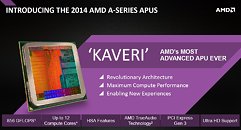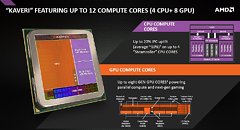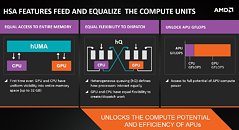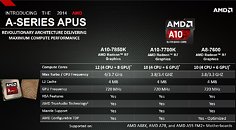Tuesday, January 14th 2014

AMD Announces 4th Generation A-Series "Kaveri" Desktop APUs
AMD announced its 2014 A-Series APU for the desktop platform, code-named "Kaveri," after the southern-Indian river. Built in the new FM2+ package, the APUs run only on socket FM2+ motherboards based on the AMD A88X, A78, and A55 chipsets; while the socket itself can seat older FM2 APU families, "Trinity" and "Richland." In many ways, the socket transition is similar to that of socket AM3+. "Kaveri" sees AMD integrate two of its newest CPU and GPU micro-architectures, "Steamroller" for CPU, and Graphics CoreNext 2.0 for the GPU. "Kaveri" is also built on newer generation 28 nm silicon fab process.
"Steamroller" is an evolution of the same modular CPU core design as its predecessors, "Piledriver" and "Bulldozer." AMD promises a 10 percent improvement in performance clock-by-clock, per core, which falls in line with AMD's normal scheme of annual incremental performance updates on its CPU micro-architectures. A "Steamroller" module is a combination of two 64-bit x86 cores, which feature dedicated and shared components. "Kaveri" has two such modules, and so physically, it features a quad-core CPU.The GPU inside A-Series "Kaveri" APUs is the fastest AMD ever crammed into a PC APU, although it doesn't come close to the APUs that drive Xbox One and PlayStation 4. Based on the Graphics CoreNext 2.0 micro-architecture, "Kaveri" features eight GCN compute units (CUs), which make up 512 stream processors, and 32 TMUs. The GPU supports DirectX 11.2, OpenGL 4.3, and Mantle. The GPU component also accelerates AMD's TrueAudio technology, which debuted with the Radeon R9 290 series. The GPU's display I/O lets you drive Ultra HD (3840 x 2160 pixels) displays with 60 Hz refresh rates, over DisplayPort 1.2. It supports up to four display outputs.
Moving on to the uncore portion of "Kaveri," AMD deployed a new-generation integrated memory controller (IMC). It supports up to 64 GB of dual-channel DDR3-2400 MHz memory. Its biggest feature id hUMA (heterogeneous unified memory access), which not only chucks out fixed memory partitions between the system and shared graphics memory area, but also makes the CPU and GPU access the same memory simultaneously. This should translate to greater system memory available to the OS (as "hardware reserved" GPU memory is eliminated), and better GPGPU performance. The second big highlight in the uncore department is the PCI-Express root complex, which now gives out up to 24 lanes of PCI-Express gen 3.0. This should translate into better CrossFire performance, in which a pair of graphics cards are given an 8-lane PCI-Express link, each.
AMD launched its 2014 A-Series APU family with three models, the A10-7850K, the A10-7700K, and the A8-7600. Specifications of the three parts are tabled below. The A10-7850K and A10-7700K will include Origin keys to Battlefield 4, and the two chips apparently meet the minimum system requirements of the game.
"Steamroller" is an evolution of the same modular CPU core design as its predecessors, "Piledriver" and "Bulldozer." AMD promises a 10 percent improvement in performance clock-by-clock, per core, which falls in line with AMD's normal scheme of annual incremental performance updates on its CPU micro-architectures. A "Steamroller" module is a combination of two 64-bit x86 cores, which feature dedicated and shared components. "Kaveri" has two such modules, and so physically, it features a quad-core CPU.The GPU inside A-Series "Kaveri" APUs is the fastest AMD ever crammed into a PC APU, although it doesn't come close to the APUs that drive Xbox One and PlayStation 4. Based on the Graphics CoreNext 2.0 micro-architecture, "Kaveri" features eight GCN compute units (CUs), which make up 512 stream processors, and 32 TMUs. The GPU supports DirectX 11.2, OpenGL 4.3, and Mantle. The GPU component also accelerates AMD's TrueAudio technology, which debuted with the Radeon R9 290 series. The GPU's display I/O lets you drive Ultra HD (3840 x 2160 pixels) displays with 60 Hz refresh rates, over DisplayPort 1.2. It supports up to four display outputs.
Moving on to the uncore portion of "Kaveri," AMD deployed a new-generation integrated memory controller (IMC). It supports up to 64 GB of dual-channel DDR3-2400 MHz memory. Its biggest feature id hUMA (heterogeneous unified memory access), which not only chucks out fixed memory partitions between the system and shared graphics memory area, but also makes the CPU and GPU access the same memory simultaneously. This should translate to greater system memory available to the OS (as "hardware reserved" GPU memory is eliminated), and better GPGPU performance. The second big highlight in the uncore department is the PCI-Express root complex, which now gives out up to 24 lanes of PCI-Express gen 3.0. This should translate into better CrossFire performance, in which a pair of graphics cards are given an 8-lane PCI-Express link, each.
AMD launched its 2014 A-Series APU family with three models, the A10-7850K, the A10-7700K, and the A8-7600. Specifications of the three parts are tabled below. The A10-7850K and A10-7700K will include Origin keys to Battlefield 4, and the two chips apparently meet the minimum system requirements of the game.




50 Comments on AMD Announces 4th Generation A-Series "Kaveri" Desktop APUs
www.anandtech.com/show/7677/amd-kaveri-review-a8-7600-a10-7850k
www.extremetech.com/computing/174632-amd-kaveri-a10-7850k-and-a8-7600-review-was-it-worth-the-wait-for-the-first-true-heterogeneous-chip
You may be able to get a sandy or ivy bridge i3 CPU for sub $70, but its going to get neutralised in non-gaming tasks due to being a dual core.
Even if you slap a dedicated R7 240 on the i3 its still going to get spanked in gaming because the integrated GPU on the Kaveri is faster (512 stream cores vs 320 stream cores, no slow PCI bus).
So yes you can spend a get an outdated i3 and a dedicated R7 240, but the overall experience will still be a slower rig.
P.S. The pricing will settle in a few weeks. On launch days prices always balloon.
That's something that hints on the potential of HSA.
www.extremetech.com/computing/174632-amd-kaveri-a10-7850k-and-a8-7600-review-was-it-worth-the-wait-for-the-first-true-heterogeneous-chip/5
On the GPU side and energy consumption is looking Great though.
Now its out I'll wait for a month or two for the price to settle down and maybe for some new mother boards to arrive that have some better chipsets/layouts. Then I can have a PS4 for gaming and a PC for general stuff for games the PS4 won't have (mostly strategy games, that let's be honest aren't the most graphically demanding games on the planet).
------------------
Edit: Off topic:
For anyone interested in battlefield 4 and games in general performance on Kaveri, they perform like a beast!!!! Keep in mind this is only the A8-7600, I'm sure the A10-7850k performs even better in games!
Higher is better:
Lower is better:
Lower is better:
Higher is better:
Lower is better:
Lower is better
Higher is better:
Lower is better:
Lower is better:
More reviews:
techreport.com/review/25908/amd-a8-7600-kaveri-processor-reviewed
www.bit-tech.net/hardware/cpus/2014/01/14/amd-a8-7600-kaveri-review/1
Seems like oc'ing was off limits for every 7850k launch day review.
And when are these actually going on sale? They are nowhere.
i'd say it's an impressive improvement over richland. while it's 6 Watts more compared to intel's i3 4330 higer tdp, you do realize that intel always have an advantage on the lithography process over amd and the a8 have a beefier iGPU....
LOL what he said^
Got Ninjaed
TDP is thermal design power, mind you, the amount of heat generated that should be handled by the cooling system ;)well, again, it's the TDP, but yeah i see your point.